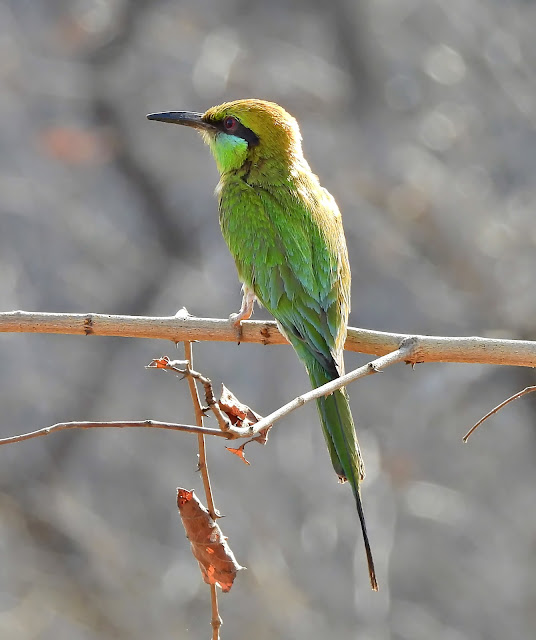The Asian green bee-eater (Merops orientalis) is a brightly-colored bird in the bee-eater family. It performs some seasonal movements and is found widely distributed across Asia. Populations in Africa and the Arabian Peninsula that were formerly assigned to this species (under the name green bee-eater) are now considered distinct species: the African green bee-eater and the Arabian green bee-eater. Asian green bee-eaters are mainly insect eaters and prefer to live quite far from water.
Like other bee-eaters, this species is a richly colored, slender bird. The males and the females are not visually distinguishable. The entire plumage is bright green and tinged with blue, especially on the chin and throat. The crown and upper back are tinged with golden rufous. The flight feathers are rufous washed with green and tipped with blackish. A fine black line runs in front of and behind the eye. The iris is crimson and the bill is black while the legs are dark grey. The feet are weak with the three toes joined at the base. Southeast Asian birds have rufous crown and face, and green underparts. The wings are green and the beak is black. The elongated tail feathers are absent in juveniles.
The Asian green bee-eater’s vast range stretches from Mauritania in West Africa, to sub-Saharan Africa, as well as the Middle East and India as far in the north as Nepal; in Southeast Asia, it is found in central China, Thailand, and Vietnam. This species frequents wooded areas where there are scattered trees and bushes, keeping near streams and shores, but also occurs in arid areas that have acacia and date palms, and in dunes, near cultivated areas and big gardens. It likes bare and sandy soils. Asian green bee-eaters are not known to perform migrations but they make seasonal movements in response to rainfall.
Asian green bee-eaters are fairly gregarious birds, with 30-300 individuals roosting next to each other on a branch, and as many as 20 gathering to dust bathe together, this activity is believed to help remove excess oil from the feathers and dislodge harmful parasites. Flocks sleep together at roosts, high in trees. Except for at nighttime, they perch fairly low. They forage either alone or with a group of 15 to 20 birds. These elegant birds usually hunt low to the ground, making short swoops before returning to their perch. They sometimes perch on the backs of cattle or grazing antelope and make sallies into vegetation close to the ground to catch insects. Before eating their prey, they remove any dirt by striking the insect several times against a hard surface. These birds make soft trilling calls, ‘trree-trree-trree’, or short, sharp alarm calls that sound like ‘ti-ic’ or ‘ti-ti-ti’.



%2020.jpg)


I%2020.jpg)
I%2021.jpg)
I%2022.jpg)














%2020.jpg)
%2020.jpg)



%2020.jpg)
%2022.jpg)














